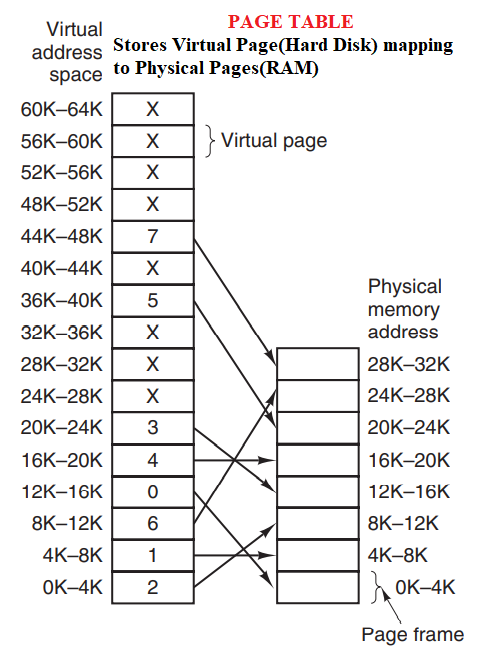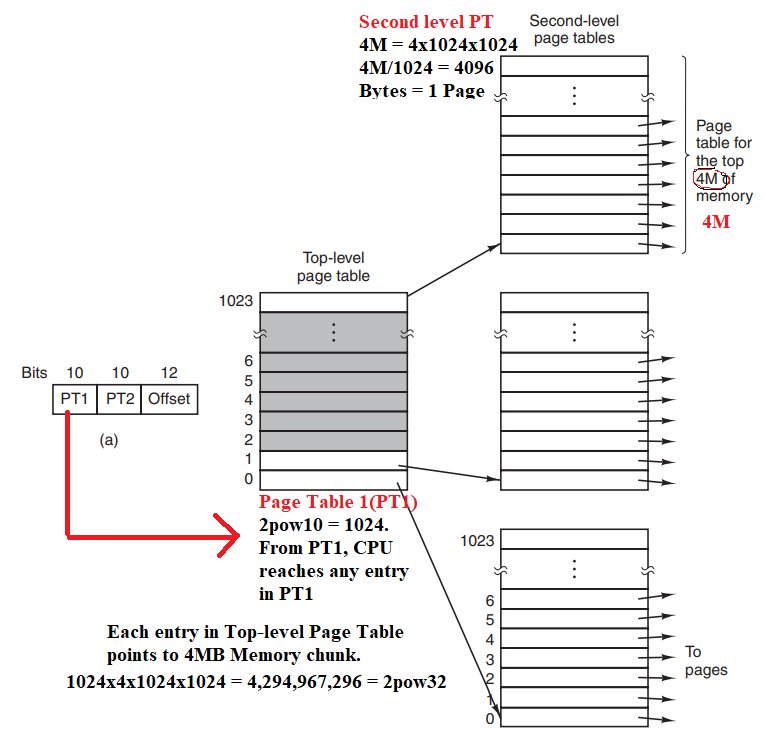Why VM
-
Now-a-days processes are RAM hungry. Every Program(eg: adobe photoshop, microsoft teams) need more RAM.
if 10 such processes want to run simultaneously then 10GB RAM is needed which is not available. VM is illusion to program that it has complete access to RAM.
Virtual Memory & Physical Memory
| Virtual Memory = Hard Disk | Physical Memory = RAM | |
|---|---|---|
| Size | Bigger | Smaller wrt HD. Stores data and machine code currently being used by the system. |
| Contains | Pages | Frames |
| Memory Allocation | Contigous | Contigous |
| Max Memory Sizes |
hard Disk=4GB. Virtual Memory=3GB hard Disk=1TB. Virtual Memory=966GB |
hard Disk=4GB. Physical Memory=1GB hard Disk=1TB. Virtual Memory=4GB |
Terms
Page
-
Pages are fixed sized blocks of Virtual Memory.
Size: Page size is typically 4KB, but varies as per OS(upto 64KB).
Pages are mapped to frames in physical memory
Frame
-
Frames are fixed-size blocks of physical memory.
Page and frame are of same size
Physical memory is divided into frames
Pages from virtual memory are loaded into available frames in physical memory
Paging
-
Memory management scheme that eliminates the need for contiguous allocation of physical memory/RAM
It divides both virtual and physical memory into fixed-sized blocks, called pages and frames respectively.
When a program accesses data, the operating system maps the virtual address to a physical address using page tables.
And program gets executed even if they are not entirely loaded into physical memory/RAM.
Pure Demand Paging
-
Type of paging where pages are loaded into RAM/memory only when they
are needed (i.e., on demand).
Initially, none of the program’s pages are loaded into RAM/physical memory.
When a page is accessed for the first time, a page fault occurs, and the operating system loads the required page from Virtual Memory/Hard disk into a free frame in RAM/physical memory.
Advantage of Paging: Minimizes RAM usage and allows for efficient use of available RAM/memory.
Page Fault
-
Page fault occurs to bring page(From Virtual Memory) to RAM/Physical Memory.
MMU uses a trap instruction to switch control to kernel mode.
Trap Instruction (trap())
-
To bring required pages(From Virtual Memory) to RAM/Physical Memory, CPU uses a trap instruction to switch control to kernel mode.
@startuml
participant a.exe as aexe
participant CPU as cpu
participant MMU as mmu
participant PageTable as pt
participant "trap_handler()\n\nrunning in RAM" as th
participant "Hard-Disk/Virtual" as hd
note over aexe #Cyan
Access 0x1234
(Virtual address)
end note
aexe -> cpu: Read 0x1234
note over cpu #Khaki
Find physical address
corresponding to 0x1234
end note
cpu -> mmu: Get Physical address for 0x1234
note over mmu #LightGreen
Divide 0x1234 into
page number=1
offset=0x034
end note
mmu -> pt: Is Page number=1 present?
pt -> mmu: entry not present
note over mmu #LightGreen
PAGE FAULT situation
Signal CPU to issue trap()
end note
mmu -> cpu: execute trap()\ntrap is software interrupt
note over cpu #Khaki
Save current process(a.exe)
state & switch to kernel
mode
end note
cpu -> th: Execute trap() handler
note over th #LightBlue
trap_handler() {
Get address of Virtual page
Find page on Hard Disk
}
end note
th -> mmu: Give me address of Virtual Page?
mmu -> th: page address=0x789
th -> hd: Find page=0x789
hd -> th: page=x0789
note over th #LightBlue
trap_handler() {
Find free frame on RAM
}
end note
th -> th: Find free/victim \nframe on RAM
hd -> th: Read identified page into frame
th -> pt: Update page table entry
note over pt #LightPink
Page Frame
0x1234 0x567
end note
th -> mmu: Page Table updated
mmu -> cpu: Page Table updated
cpu -> pt: Get Physical address
pt -> cpu: 0x567
cpu -> aexe: 0x567
note over cpu #Khaki
cpu resumes operation
end note
note over aexe #Cyan
program reads content
at RAM=0x567
end note
@enduml
Page Table
-
Stores mapping of Pages(Hard Disk/Virtual Memory) to Frames(RAM/Physical memory).

MMU(Memory Management Unit) Translate Virtual to Physical Address
-
Takes Virtual address(of Virtual Memory/Hard Disk) as Input provides Physical Address(of RAM) as output ie translate virtual to physical address.
CPU and MMU are present on single Die, ie on same chip. Mapping of Virtual Address to Physical Address is stored in PAGE TABLE.
TLB(Translation lookaside buffer)
-
Practically from complete Page Table only a small fraction of the page table entries are
heavily read; the rest are barely used.
TLB is hardware inside MMU which stores only few entries(8-256) for Virtual-to-Physical mapping.
-
TLB Example: Request for Virtual Page comes to TLB
- if TLB entry found-> TLB Hit
- else TLB miss(goes to Page Table), find entry updates Page Table. restarts trap instruction.
Problem with TLB
-
TLB being small, if it happens process tries to get unused page every time, there will be lot of TLB misses
Solution: Software to maintain a cache internally.
Translation from Virtual Address(Hard Disk) to Physical Address(RAM)
-
Translation typically involves two components:
- Page number(or fragment): identifies a page in the virtual address space
- Offset: specifies the exact location within a page.
| 16 bit Architecture | 32 bit Architecture | 64 bit Architecture | |
|---|---|---|---|
| Bus Size |
16 bit = 2 bytes - 216=65535 (can access 64KB memory) - you can plug huge Hard disk but that will be no use since in 1 go Only 2 bytes can be accessed |
32 bit = 4 bytes - 232=4,294,967,296 (can access 4GB memory) - you can plug huge Hard disk but that will be no use since in 1 go Only 4 bytes can be accessed |
64 bit = 8 bytes - 264=18x1018 (can access 18x109GB memory) |
| Fragment | 4 bits | 20 bits | |
| Offset 2^12 = 4096 Can access every bit inside page |
12 bits | 12 bits |
Conversion Example(16 bit system)
-
We have above page table
Virtual Memory/Hard Disk Physical Memory/RAM
Size 64KB 32KB
Count 64k/4k = 16 Pages 32k/4k = 8 Frames
- 1. Program accesses virtual address=0
Code-Segment
MOV REG 0 ----> CPU
--Get Physical Address for 0--> MMU
<--Physical Address 8192- Page-0 maps to Frame-2
//MMU has mapped all virtual addresses between 0-4095 onto physical addresses 8192-12287.
- 2. Program accesses virtual address=8192
Code-Segment
MOV REG 8192 -> CPU
--Get Physical Address for 8192--> MMU
<--Physical Add (24k=24x1024=24576)-- Page-3 maps to Frame-6
- 3. Program accesses virtual address=20500
20500 falls 20 byte inside 6th Page.
Code-Segment
MOV REG 20500 -> CPU
-Get Physical Address for 20500--> MMU
Page-6 maps to Frame3
<--Physical Add 12302---- Frame-3-start:12282. PhysicalAdd=12282+20=12302
- 4. Program accesses unmapped address virtual address=24576
Page Eviction: Movement of pages in/out of RAM is done by SWAPPER.
Code-Segment
MOV REG 24576 ---> CPU
--Return PhyAdd for 24576-> MMU
not present
trap()
RAM(PM) Hard-Disk(VM)
--Frame=0 moved to VM-------------->
<-Page 24576 loaded in RAM(at address 0)--
MMU(Updates Mapping)
Page(12K not mapped)
Page-24K maps to Frame0
<---Virtual Address 0----
Conversion Example(32,64 bit system)
Problem with Page Table
4GB/4KB(Page size): 10,48,576 = 1 Million Page entries in Virtual Page Table
Solution-1: TLB
Solution-2: Multilevel Page Tables(32 Bit system)
-
32 bit address = 10 Bit(Page-Table-1. 210=1024 pages) + 10 Bit(Page-Table-2. 1024 pages) + 12 Bit(offset).
Page-Table-1: Contains 1024 pages, each of size = 4KB
Page-Table-2: Contains 1024 pages, each of size = 4KB.
